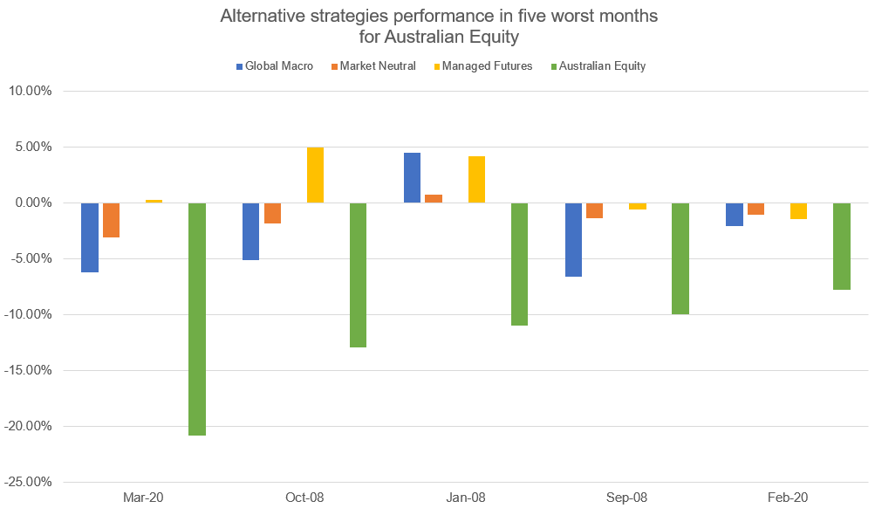What are alternatives?
Alternatives refer to a wide range of investment assets that don’t fit into the standard asset classes of equity, property, fixed interest, and cash. To help clarify this rather broad definition, the alternatives universe is very wide with some of the more common alternative categories being hedge funds, private equity and debt, and unlisted infrastructure, but can also include highly bespoke investments such as artwork and vintage cars!
Alternatives' heterogeneous nature explains why it’s often the most difficult asset class for investors to grasp, and consequentially, alternatives are often excluded from portfolios. One of the great misconceptions regarding alternatives is that they’re high-risk, highly illiquid investments, reserved exclusively for large institutional or high net worth investors. On the contrary, there are many liquid alternative investments now available and accessible to private investors via the various administration platforms. This is important as selected alternatives strategies can dampen volatility (risk), add to portfolio diversification and maintain attractive liquidity characteristics. Today, individual investors have greater access to alternatives than ever before.
Why are alternatives so important?
Many alternative investment strategies have a reasonably low correlation with traditional asset classes, meaning they tend to perform differently over time in varying market conditions. This intuitively explains why alternatives can improve diversification in a diversified portfolio. Diversification is perhaps the most fundamental, well-accepted concept within investing. Investors can reduce their risk by diversifying across different asset classes, sectors, and regions. This simple yet powerful principle is a ubiquitous objective for most investors.
By enhancing portfolio diversification, alternatives can help lower volatility, reduce the severity of drawdowns (the peak to bottom capital decline during a specific time period) and permanent capital loss, and introduce an ‘alternative’ source of return to help investors meet their return objectives. Such benefits are especially important in the current low growth, low interest rate environment, in which persistently falling interest rates have inflated traditional asset class valuations and lowered future return expectations.
To further complicate matters, low bond yields challenge the defensive capabilities fixed income assets have historically played in a share market downturn, as bonds are now broadly susceptible to capital depreciation should interest rates rise from their historic lows. While traditional equity and fixed income investments have long been considered the key components of a diversified portfolio, investors should consider using alternatives as an additional avenue to meet their return objectives and lower their risk.
The graph below illustrates how alternatives can provide downside protection and, in some instances, positive returns during periods of extreme equity market volatility.

Source: Zenith
Where do alternatives fit in a diversified portfolio?
The traditional Strategic Asset Allocation (SAA) approach to portfolio construction consists of a balance between capital appreciating assets (equities and property) and defensive/income producing assets (fixed interest and cash) depending on factors such as the investor’s risk tolerance, time horizon and investment objectives.
We believe alternatives fit within the ‘growth’ component of an investor’s SAA and serve to dampen volatility at a total portfolio level and enhance long-term returns. As can be seen in the graph, alternatives typically have a low correlation rather than a negative correlation to traditional asset classes like Australian equity. In other words, alternatives don’t provide inverse returns, but rather differentiated returns.
Overview of three alternatives strategies we currently use in managed accounts
Managed futures
Managed futures (also referred to as CTA – Commodity Trading Advisers) may seem complex to many investors, however, the strategy’s diversification and return potential can be conceptually intuitive. Generally, a ‘futures contract’ is an agreement to buy or sell a specific amount of a commodity or a financial instrument at a specific price and on a specific date in the future. Managed futures strategies attempt to identify and exploit persisting trends in a diverse range of futures markets including commodity, stock indices, fixed income and foreign currency futures. Because managed futures can take long and short positions in futures contracts, they can benefit from rising and falling market conditions. This capacity to exploit varying trends in both up and downward moving markets in any economic environment underpins the strategy’s low correlation with traditional asset classes such as equities, bonds and property.
Global macro
Simply put, global macro is an investment strategy centred on interpreting and projecting global economic and political events and their impact on a wide range of investment markets. In doing so, the manager forms top-down views to profit from opportunities in equity, fixed income, foreign currency and commodity markets resulting from these events. Like managed futures, global macro managers have the flexibility to take long and short positions in global markets using a range of financial instruments, over long and short-term holding periods. The strategy can therefore generate returns in all market environments, including downward moving and volatile market periods.
Managed futures and global macro strategies maintain highly attractive liquidity characteristics. Therefore, they can quickly adjust or reverse their positions as required. This level of flexibility isn’t always as available in traditional stock and bond investments and is particularly important during periods of heightened market volatility.
Market neutral
The basic premise of a market neutral strategy is taking long positions in stocks expected to rise in share price and short positions in stocks expected to fall in share price. For the overall strategy to be ‘market neutral’, the short positions offset the long positions such that the strategy is primarily exposed to stock specific risk rather than market movements and therefore the major ups and downs of the overall market. For instance, the fund manager may assess that two bank stocks have materially different valuations, shorting the overvalued bank and ‘going long’ in the bank deemed undervalued. This confines the investor’s risk exposure to stock specific risk, while removing the sector risk. The diversification benefits are evident because the returns from market neutral strategies are largely independent of the broader equity market.
Given the prevailing economic and market uncertainty amid the Covid-19 pandemic, we encourage investors to look beyond traditional asset classes for additional sources of diversification, returns and capital protection / risk management. An allocation to alternatives reaps the following benefits for portfolios:
- Sources of differentiated and competitive returns
- Improved diversification
- Lower volatility
- Minimising the severity of drawdowns
- Enhanced long-term returns
- Attractive liquidity







